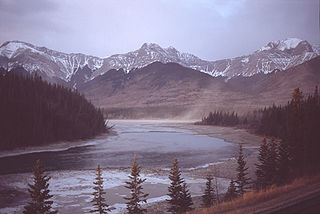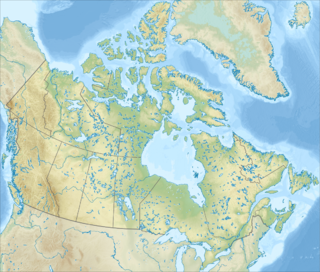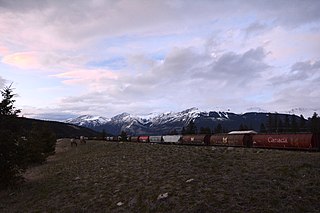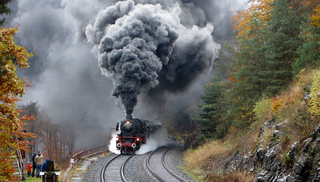
The Reading Company was a company that was involved in the railroad industry in southeast Pennsylvania and neighboring states from 1924 until 1976.

Alberta Provincial Highway No. 47, commonly referred to as Highway 47, is a north–south highway located in west–central Alberta, Canada that stretches from Highway 16, approximately 10 km (6.2 mi) west of Edson, to Highway 40, approximately 6 km (3.7 mi) south of Robb.

Nordegg is a hamlet in west-central Alberta, Canada within Clearwater County. It is located in the North Saskatchewan River valley in the foothills of the Canadian Rockies, just east of the intersection of the David Thompson Highway and the Highway 734 spur of the Bighorn Highway. A former coal-mining town, it was named after Martin Nordegg and the name probably means "North Corner" in a German dialect.

Alexo is a ghost town in Alberta, Canada. Built as a coal mining town, it lies in the foothills of the Canadian Rockies at an elevation of about 1,260 metres (4,130 ft), near the David Thompson Highway between the towns of Nordegg and Rocky Mountain House. Shunda Creek and the North Saskatchewan River run to the south of it.

Cadomin is a hamlet in the west-central Alberta, Canada within Yellowhead County. It is located along the McLeod River in the foothills of the Rocky Mountains, approximately 50 kilometres (31 mi) south of Hinton near the Bighorn Highway. It is served by a spur of the Canadian National Railway.

The McLeod River is a river in west-central Alberta, Canada. It forms in the foothills of the Canadian Rockies, and is a major tributary of the Athabasca River.

The Embarras River is a short river in west-central Alberta, Canada. The river likely derived its name from the French word for obstruction, because it is often obstructed by driftwood.

Embarras is a locality in Yellowhead County, Alberta, Canada. It takes its name from the Embarras River. 'Embarrass' is French for 'barrier', probably in reference to the piles of driftwood that often clog the shallow, winding river.

The Lovett River is a short river in the Alberta foothills. The Lovett is an early tributary of the Pembina River, itself a major tributary of the Athabasca River. The Lovett River was formerly known as the Little Pembina River, but to avoid confusion its name was changed. The new name was derived from Lovettville, a defunct coal mining town in the vicinity. The settlement took its name from H. A. Lovett, President of North American Collieries, a mining company in the area.

The Nikanassin Formation is a stratigraphic unit of Late Jurassic (Portlandian) to Early Cretaceous (Barremian) age. It is present along the western edge of the Western Canada Sedimentary Basin in western Alberta and northeastern British Columbia. Its name was first proposed by D.B. Dowling in 1909 (Coal Fields South of Grand Trunk Pacific Railway, in the foothills of the Rocky Mountain, Alberta Page 140 paragraph 4 " to this it is proposed to give the name Nikanassin, from the Cree word meaning outer range" Also it is noted on the map by D.B. Dowling.(Geological Survey of Canada. Incorrect info follows: It was named by B.R. MacKay in 1929 for the Nikanassin Range of the front-central ranges of the Canadian Rockies. Mackay did not designate a type locality for the formation, although he described outcrops near the hamlet of Brûlé, north of the Yellowhead Highway outside of Jasper National Park.
The Blairmore Group, originally named the Blairmore Formation, is a geologic unit of Early Cretaceous age in the Western Canada Sedimentary Basin that is present in southwestern Alberta and southeastern British Columbia. It is subdivided into a series of formations, most of which contain plant fossils. In some areas it contains significant reservoirs of natural gas.

The Luscar Group is a geologic unit of Early Cretaceous age in the Western Canada Sedimentary Basin that is present in the foothills of southwestern Alberta. It is subdivided into a series of formations, some of which contain economically significant coal deposits that have been mined near Cadomin and Luscar. Coal mining in those areas began in the early 1900s and continues near Luscar as of 2016.
The Gladstone Formation is a stratigraphic unit of Early Cretaceous (Aptian) age in the Western Canada Sedimentary Basin. It is present in the foothills of southwestern Alberta and is named for outcrops along Gladstone Creek, a tributary of the Castle River south of the Crowsnest Pass.

Saunders Creek is a ghost town in west-central Alberta, Canada. Built as a coal mining community, the town existed from 1913 to 1954. It is located in the foothills of the Canadian Rockies near the David Thompson Highway, about 55 km west of the town of Rocky Mountain House. It was named for Saunders Creek, a small stream that runs immediately west of the townsite. The North Saskatchewan River flows nearby to the south.



















